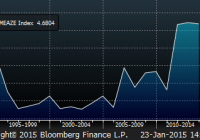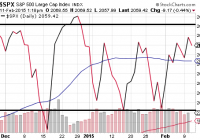Short Idea: International Bank Of Azerbaijan Bonds
Summary Russia/Oil Derivative play with downgrade/war/financial/currency de-valuation pressure currently trading in the 90s. 93% of the economy tied to oil, 2015 budget based on $90 oil, in current conflict with Armenia, S&P outlook recently moved from stable to negative. International Bank of Azerbaijan has USD & Euro debt and local currency assets, high customer and industry concentrations and a Moscow subsidiary. (IBAZAZ is accessible via FNMIX , which is a 2.44% Holder Of IBAZAZ 5.625s Of ’19) For those who say Azerbaijan is not tied to Russia… Baku, Fineko/abc.az. The Central Bank of Azerbaijan says that US currency is in feverish demand in the country because of Russia . According to CBA, demand for US dollars increased in Azerbaijan starting from mid-December under the influence of psychological factors due to sudden depreciation of Russian currency. “To maintain stability of the national currency CBA set out $1.127 bn for sale. Before December 2014 the bank purchased $1.27 bn from the market and therefore, its net balance on currency exchange transactions was $0.143 bn last year”, – CBA says. Nevertheless, in December currency reserves of CBA reduced by $1.237 bn, which exceeded its expenses for maintaining stable rate of the national currency by $110.7 million. Azerbaijan and Oil Oil and gas production and exports are central to Azerbaijan’s economy. The country’s economy is heavily dependent on its energy exports, with more than 90% of total exports accounted for by oil and gas exports , according to data from the International Monetary Fund. Progress has so far been “elusive” for Azerbaijan in its efforts to diversify the economy away from a dependence on oil and gas, and it must press a fight against corruption to improve the business climate – International Monetary Fund Azerbaijan’s budget for 2015 is based on a price of $90 a barrel At $109 barrel oil last year Azerbaijan made significant investments in projects include the development of the Azeri-Chirag-Guneshli block of fields, Baku-Tbilisi-Ceyhan oil pipeline and the first stage of development of the Shah Deniz field. (U.S. Energy Information Administration) Azerbaijan’s main producing field, the ACG field, covers 167 square miles and is located 62 miles east of Baku in the Caspian Sea. Operators expected peak production to reach 1 million bbl/d, but production at this field so far failed to reach this target. Production problems have affected ACG output in the past couple years, with unexpected production declines occurring because of technical problems. (U.S. Energy Information Administration) But What About Azerbaijan’s Other Exports? Azerbaijan’s MP, member of the parliamentary committee on economic policy, Rufat Guliyev.: “Today, more than 70 percent of Azerbaijani non-oil products are exported to Russia, Ukraine, Kazakhstan ” But The Company (SOCAR) that Produces the Oil is Owned by the Government of Azerbaijan so They Will Support them, Right ? SOCAR only produces about 20% of the country’s oil output (U.S. Energy Information Administration) The remaining 80% of Azerbaijan’s output comes from the ACG oil fields by the BP-operated Azerbaijan International Operating Company (AIOC) and at the BP-operated Shah Deniz field (which produces oil condensate) AIOC is a consortium of 10 mostly non-Azerbaijani oil companies. (U.S. Energy Information Administration) Azerbaijan – Armenian Tensions = Possible War Update: January 26th: Azerbaijan violated the ceasefire about 800 times along the Line of Contact with Karabakh troops on January 24-25. Over 14,000 shots were fired towards Armenian military positions from guns of various calibers, grenade launchers and mortars, the press service of the Nagorno-Karabakh Defense Army reported. Conflict going on since 1994 Conflict became more serious in 2014 with significant casualties Ilham Aliyev – President of Azerbaijan; August 2014 via Twitter “We will restore our territorial integrity either by peaceful or military means . We are ready for both options.” “Just as we have beaten the Armenians on the political and economic fronts, we are able to defeat them on the battlefield “. Defense outlays will grow 27 percent to 3.8 billion manat ($4.8 billion), exceeding Armenia’s total budget spending of $3.2 billion, Finance Minister Samir Sharifov said in November 2014. On top of a budget already cut significantly due to huge drop in price of oil! (2015 budget based on $90 oil) Defense Spending back at peak levels – 1994 (when conflict started) Bloomberg Data What Happens if Azerbaijan un-pegs their currency to the USD? In June of 2013 the International Monetary Fund recommended Azerbaijan un-peg the Manat to the USD “Republic of Azerbaijan, Selected Issues” IMF Country Report: 13/165 The below table shows Azerbaijan is already on its way to a possible de-pegging of the Manat. (source: “Republic of Azerbaijan, Selected Issues” IMF Country Report: 13/165) THIS JUST HAPPENED IN TURKMENISTAN The Turkemenistan Manat has been rigidly pegged to the USD since 2009 at a rate of 1USD=2,85 MANAT Devalued by 18.6% in January of 2015 Kazakhstan had their currency pegged to the dollar as well…. In February of 2014 they unpegged their currency to the USD and devalued the currency by 19% Ok ok, What Does This Have to Do with The International Bank of Azerbaijan? The International Bank is being privatized and is only 50.65% owned by the government (as of 6/30/14 previously was 60.06% on 12/31/13) Considering that 90% of the country’s exports are oil & gas related it seems a bit strange that the financials list exposure to the industry as only 1.1% of total loans It is impossible to know how much of the loan portfolio is indirectly related to the industry 62% of IBA’s loan portfolio is related to Construction/RE development and Trade/Service industries IBA has a history of extending/renewing loans instead of marking them as past due/non-performing/impaired so we don’t truly know how many loans are in this category The bank has a $2.6B 6-12 month funding gap as of 6/30/14…bigger the gap bigger the risk (up from $2.3B at 12/31/13) IBA has ~$250M of foreign syndicated loans maturing in the first 4 months of 2015 (USD & EURO denominated) IBA has credit agreements with foreign banks which have ~$1.2B and ~EUR200M drawn down on them as of 6/30/2014 These term and revolving loans have various unknown financial covenants As of 6/30/14 the value of IBAs currency forward agreements were diminimus at ($1.1M) Concentration Risk 30 companies account for 42.5% of the total corporate loan portfolio Corporate loan portfolio is ~90% of total loan portfolio 20 Entities account for 93.7% of total guarantees as of 6/30/14 (guarantees total ~$1.6B as of 6/30/14) Moscow Subsidiary= International Bank of Azerbaijan-Moscow As reported in audited IFRS statements at year-end 2013, the bank’s aggregate exposure to the 23 largest customers amounted to 42% of total gross loans or 567% of its Tier 1 capital IBAM’s exposure to construction and real estate sectors stood at 189% of Tier 1 Capital at 12/31/2016 Time for the ISIS on the Cake Azerbaijani media: Embassy increases security in Baku because of ISIS threatening Only in January several articles about ISIS’s threatening to Azerbaijan appeared in international media outlets, and Baku has already taken up special measures related to the security of the leading countries and European state diplomacy, Azerbaijani information portal “Minval.az” reports, referring to the site “Axar.az.” The portal also notes that the European outlet “Another Western Dawn News” has recently published a sensational piece of news about the ISIS threat in Azerbaijan. It reported that Abdul Wahid Khudair Ahmad, the ISIL “Minister of Internal Affairs,” had called on the warriors from Azerbaijan to commence an armed struggle against the Western-backed Azerbaijani authorities. What could happen – Attack on BTC Pipeline Azerbaijan has 3 oil & gas pipelines/routes and 80% of Azerbaijan’s oil exports are done through the BTC pipeline , arguably the largest ISIS target in the country… (click to enlarge) (click to enlarge) (source: U.S. Energy information administration) Do I think it should be trading with a single digit yield in the 90s or even 80s given the above? Absolutely Not. (click to enlarge) (Source – Google Images) Disclosure: The author is short IBAZAZ. (More…) The author wrote this article themselves, and it expresses their own opinions. The author is not receiving compensation for it. The author has no business relationship with any company whose stock is mentioned in this article. Are you Bullish or Bearish on ? Bullish Bearish Neutral Results for ( ) Thanks for sharing your thoughts. Submit & View Results Skip to results » Share this article with a colleague

